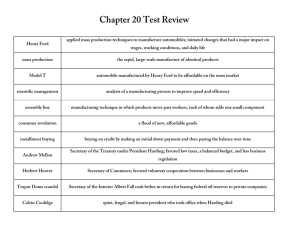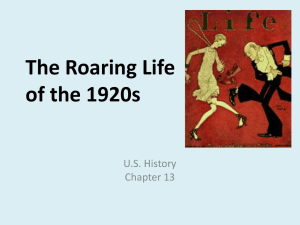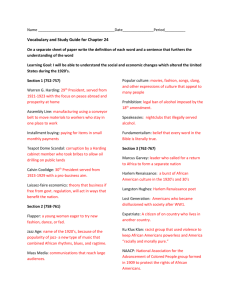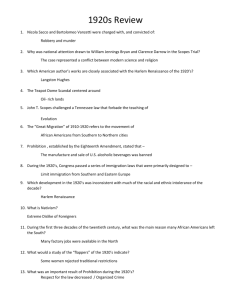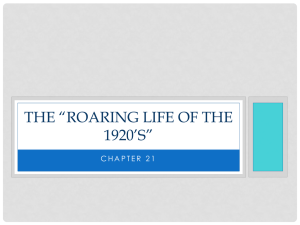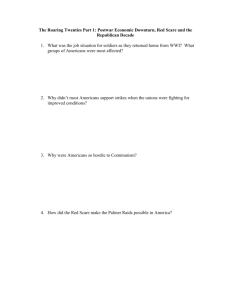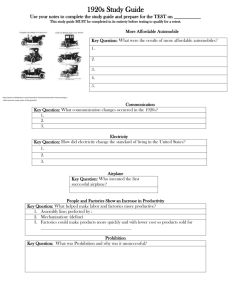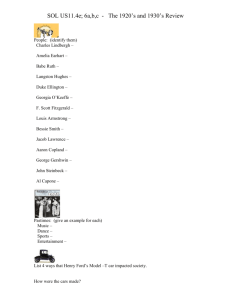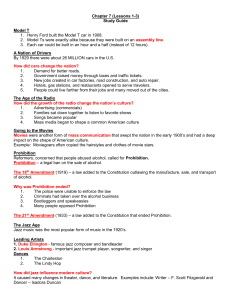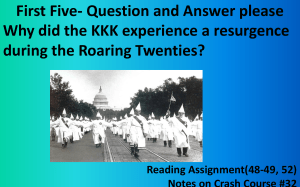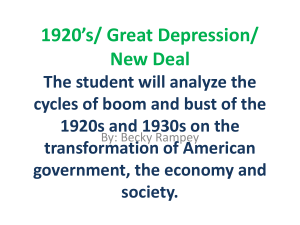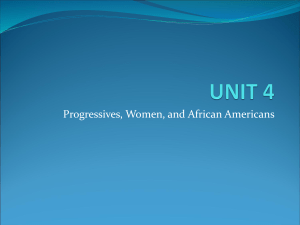Chapter 13 - Aurora City School District
advertisement
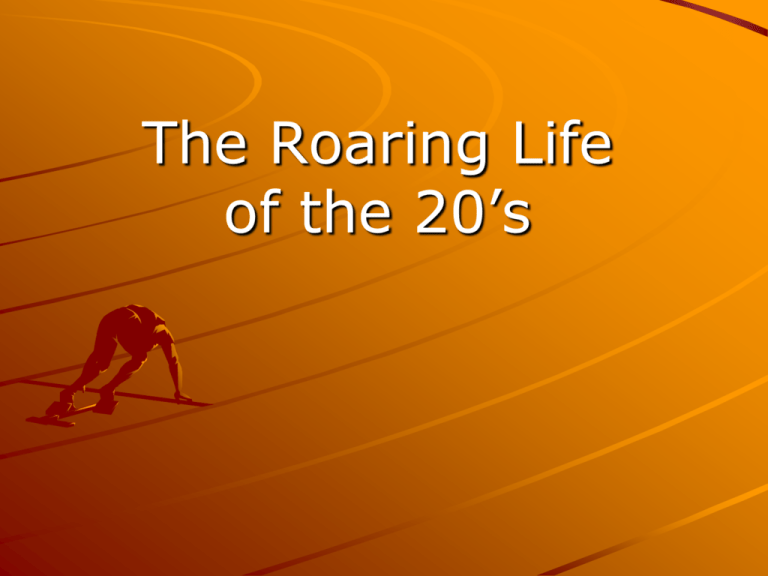
The Roaring Life of the 20’s Changing ways of Life Rural and Urban Differences -Population growing in cities, many men leaving the farms -New York topped the list of biggest cities with 5.6 million people -Chicago was second with 3 million. Chicago was an industrial powerhouse as well as a home to native-born whites, African Americans, immigrant Poles, Irish, Russians, Italians, Swedes, Arabs, French, and Chinese. -Cities could be impersonal and frightening with strangers and a fast-paced life. Changing ways of Life Prohibition 18th Amendment- manufacture, sale, and transportation of alcoholic beverages were illegally prohibited -Reformers had for a long time felt that liquor was a prime cause of corruption including; crime, wife and child abuse, accidents on the job, and other serious social problems -Support for prohibition came largely from the south and the Protestants including groups such as church-affiliated Anti-Saloon and The Women’s Christian Temperance Union Changing ways of Life The Volstead Act- Act that enforced the 18th amendment, named after Andrew Volstead and said that over .5 percent alcohol or greater Drinkers obtained liquor illegally by going to hidden saloons and nightclubs known as speakeasies (because when inside you spoke easily or softly to avoid detection) . These building were everywhere in penthouses, cellars, office buildings, rooming houses, tenements, hardware stores, and tearooms. People started to distill alcohol and make their own. Religious and medical purposes! Bootleggers- smuggler’s practice of carrying liquor in the legs of boots (usually smuggled from Canada, Cuba, and the West Indies). http://www.huffenglish.com/gatsby/speakeasies.html Changing ways of Life Organized Crime Prohibition contributed to organized crime in major cities. Al Capone- Gangster of Chicago who bootlegged over $60 million a year. 522 bloody gang killings in the 1920’s. By the mid 1920’s only 19 percent of Americans supported prohibition. Public felt it caused more problems rather than solving them. In 1933 Prohibition was repealed by the 21st Amendment. Al Capone.asx Changing ways of Life Science and Religion Clash FundamentalismProtestant movement grounded in a literal or non symbolic, interpretation of the bible. They argued all important knowledge could be found in the bible and that the bible was inspired by God and therefore its stories in all details were true Charles Darwin- Theory of Evolution (plant and animal species had developed and changed over millions of years and that humans had evolved from apes) Changing ways of Life The Scopes Trial March 1925 Tennessee passed the nation’s first law that made it a crime to teach evolution and the ACLU (American Civil Liberties Union) promised to defend any teacher who challenged the law. John T Scopes (Dayton Tennessee) read this a quote to his biology class “We Have now learned that animal forms may be arranged so as to begin with the simple onecelled forms and culminate with a group which includes man himself” Scope was then arrested Charles Darrow, most famous lawyer trial of the time, hired to defend Scopes Scopes was found guilty and fined $100 http://www.pbs.org/wgbh/evolution/library/08/2/l_082_01.html Changing ways of Life Today…… Still controversy over teaching of evolution in the classroom 1999 Kansas State School board voted to eliminate teaching evolution from the curriculum The Twenties Woman Young Women change the Rules Flappers- an emancipated young woman who embraced the new fashions and urban attitudes of the day. Examples: bright waistless dresses above the knee, skin toned silk stockings, sleek pumps, stings of beads replaced the dark and prim ankle length dresses, and pea coats more assertive young women smoking and drinking taking openly about sex danced many dances (fox trot, tango, Charleston, etc..) changing attitudes towards marriage (equal relationship) The Twenties Woman Double Standard- a set of principles granting greater sexual freedom to men than to women -Many people viewed the flapper as rebellious image rather than reality. After WWI young men often courted women (dated women they intended on marrying) however in the 1920’s causal dating became accepted The Twenties Woman New Roles for Women More work opportunitiessome college women turned to “women’s professions” such as teachers, nurses, librarians, and some women broke old stereotypes and started flying airplanes, driving taxies, and drilling oil wells. -By 1930- 10 million women were earning wages (although few were managerial jobs) The Twenties Woman The Changing Family -Lower Birth Rate due to wide availability of birth control -Technological innovations simplified household labor and family life with ready-made clothes, sliced bread, and canned foods. -Women had to juggle the family life with the working life Education and Popular Culture Schools and the Mass Media Shape Culture School Enrollments- 1914- 1 million American Students by 1926- 4 million students which increased educational standards for jobs teaching immigrant students taxes to finance schools increased (1920- $2.7 billion a year) Education and Popular Culture New Coverage expanding - increased literacy in America - News papers hooked readers by sensational stories/tabloids - National chain news papers established closing local ones - Mass circulation of magazines (Readers Digest/Time) Education and Popular Culture Radio Comes of Age -audiences tuned in to their every day speech and radio was the most powerful communication Example; presidential speeches and live world series Education and Popular Culture New Heroes Money spent for leisure activities (4.5 billion) Crossword puzzles/ games Sports heroes (Babe Ruth, Gertude Ederle, Helen Wills) Lindbergh’s Flight (1st nonstop flight across the Atlantic solo) George Gershwin (jazz concert music composer) Georgia O’Keeffe (produced intensely colored canvases) Sinclair Lewis (1st American to win the Nobel prize in literature in his novel the Babbitt) F. Scott Fitzgerald (term Jazz age, The Great Gatsby, and This Side of Paradise) Edna St. Vincent Millay (poet) Ernest Hemingway (Novel writer The Sun also Rises) The Harlem Renaissance African American Voices in the 1920’s NAACP- National Association for the Advancement of Colored People led by James Weldon Johnson fought legislation to protect African American Rights (Antilynching organizations) Marcus Garvey- immigrant from Jamaica felt African Americans should build a separate society. He founded the Universal Negro Improvement Association (UNIA) 1 mil followers by 1920. Left behind powerful legacy The Harlem Renaissance New York Harlem Renaissance Harlem Renaissance- a literary and artistic movement celebrating African American culture -Claude McKay- Novelist poet, Jamaican Immigrant, verses urged African American to resist prejudice and discrimination -Langston Hughes- Best known African American Poet -Paul Robeson-dramatic actor (Othello) -Louis Armstrong- Jazz musician (Henderson’s band of NY) -Edward Kennedy “duke” EllingtonJazz Pianist/composer -Bessie Smith- female blues singer
